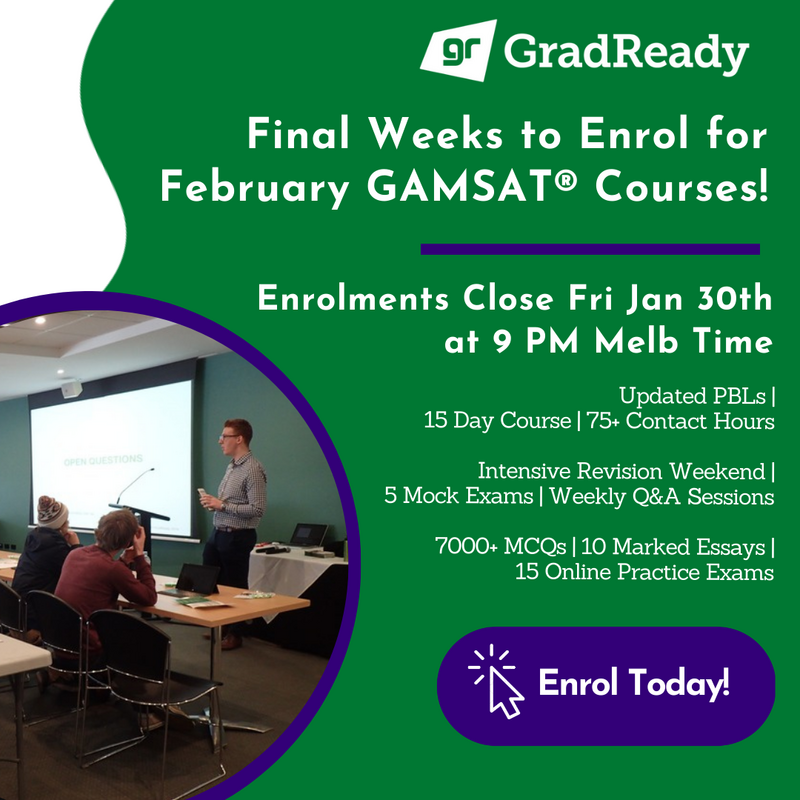So, you want to get a medical degree Australia? Though this question is reminiscent of the last lines of the movie ‘Sicario: Day of the Soldado’ (“so, you want to be a Sicario?”), the route is (arguably) not quite as bloody. Medical school is, however, a very tough and difficult path that must be trodden to achieve a medical degree and thus the opportunity to practice as a medical doctor. This blog will outline how you can go about getting a
medical degree in Australia and provide a broader overview of the process with complementary links to other blogs that will be of assistance!
Most medical courses in Australia are post-graduate, which means that you need to have a degree prior to entry. Further, you not only need this preliminary qualification, but you also must sit the dreaded Graduate Medical School Admissions Test (GAMSAT) to enter most medical schools in Australia. This initial entrance exam will be, arguably, the most difficult and frustrating part of your entire medical career. The test is extremely competitive, with thousands of students vying for medical school entry every year, and typically only the top 15-20% of students in the GAMSAT get a medical school offer. The entry score for each medical school varies, but you generally need to pass each ‘section’ of the GAMSAT, which deals with
physics,
biology,
chemistry, and the humanities, and also have completed a Bachelor’s degree within the last decade (typically) and have attained a GPA of over 5-5.5 out of 7 (usually). For more information on the GAMSAT, check out these links:
When should I start studying for the GAMSAT?
What is the GAMSAT?
GAMSAT sits two times a year (typically March and September), and results are usually released approximately six weeks later. If you are sitting a March test, then you can enter medical school next year; however, if you sit a September GAMSAT, then your result will not be valid for the immediately subsequent year, but the next. Once these results are received, most medical schools then require students to undertake an interview in the ‘Multi-mode Interview’ format, which typically consists of an approximately two hour interview where you cycle between several groups of interviewers and perform various tasks and answer a range of questions. See these other articles for more information on the MMIs:
MMI Interview Do's & Don'ts
Preparing for the Medical School Interview

Depending on the way you enter medical school, there are two types of medical degree Australia: Five-year or six-year Undergraduate Bachelor degrees, and equivalent professional entry Masters level degree (usually called ‘MDs’ – though the undergraduate version may also be called this in some situations). The Masters qualification is, practically, not any different to a Bachelor equivalent in medicine. The Masters version is arguably a marketing ploy of most Australia medical schools to allow them to market to international students and also charge international and domestic students Masters level costs for what is, effectively, an unchanged Bachelor’s degree.
Once you are finally in medical school, your experiences will be divided based on your year level (this blog will assume that the course runs for four years, the standard length). The first year of medical school is often focused on understanding the ethics, background, and role of the doctor, as well as studying basic physiology, anatomy, and pharmacology (among much more!). Second year at medical can vary at each institution, but my own experience was that it is a consolidation year. You still continue to learn a lot of systems-based theory (i.e. physiology), through the medium of Problem-Based Learning (PBL). These are usually twice-weekly classes and are similar to tutorials, except you examine an interactive patient case, and go away and learn things your group doesn’t know, and then present your findings at the subsequent PBL session. In all practicalities, this means you do two mini-assignments per week for PBL, and then have to learn approximately twenty. It sounds much worse than it is, and it is certainly a very busy year. Clinical workshops, anatomy classes, and lectures will also be encountered throughout each semester, and often these are related to the PBL cases.
The third year, or your first year of clinical learning, is a drastic change. You are more-or-less booted out from the safety of the medical school into the public arena, where you must interact with not only doctors, health professionals and nurses, but the general public. Now, you are entering clinical environments, and you will get your first taste of what being a doctor is actually like – for better or worse. The final year of your study, often fourth year, is like a consolidation year for third year – and there are more engaging clinical engagements, often ones that you can design yourself, and other opportunities in research and public health.
All Australian medical graduates must then complete one year of internship in a public hospital before they can obtain full medical registration. During the final year of medical school, med students can choose their preferred hospital in which they would like to do their internship. After the internship, you are then FINALLY qualified to be a fully registered doctor!
In this small blog of how to become a doctor in Australia, we have charted approximately eight years of your life, and because of the brevity of the discussion, I deeply encourage you to find the linked, additional resources to learn more! It is crucial that you adequately prepare for all stages in order to successfully come out the other side as a doctor. This blog has just given you a snapshot of what is required to get medical degree Australia; now it is up to you to jump in!
The GAMSAT exam is a very important part of getting a medical degree in Australia. To learn more about how to prepare for the GAMSAT exam, you can read our article on
How to Prepare for the GAMSAT.







 Depending on the way you enter medical school, there are two types of medical degree Australia: Five-year or six-year Undergraduate Bachelor degrees, and equivalent professional entry Masters level degree (usually called ‘MDs’ – though the undergraduate version may also be called this in some situations). The Masters qualification is, practically, not any different to a Bachelor equivalent in medicine. The Masters version is arguably a marketing ploy of most Australia medical schools to allow them to market to international students and also charge international and domestic students Masters level costs for what is, effectively, an unchanged Bachelor’s degree.
Depending on the way you enter medical school, there are two types of medical degree Australia: Five-year or six-year Undergraduate Bachelor degrees, and equivalent professional entry Masters level degree (usually called ‘MDs’ – though the undergraduate version may also be called this in some situations). The Masters qualification is, practically, not any different to a Bachelor equivalent in medicine. The Masters version is arguably a marketing ploy of most Australia medical schools to allow them to market to international students and also charge international and domestic students Masters level costs for what is, effectively, an unchanged Bachelor’s degree.